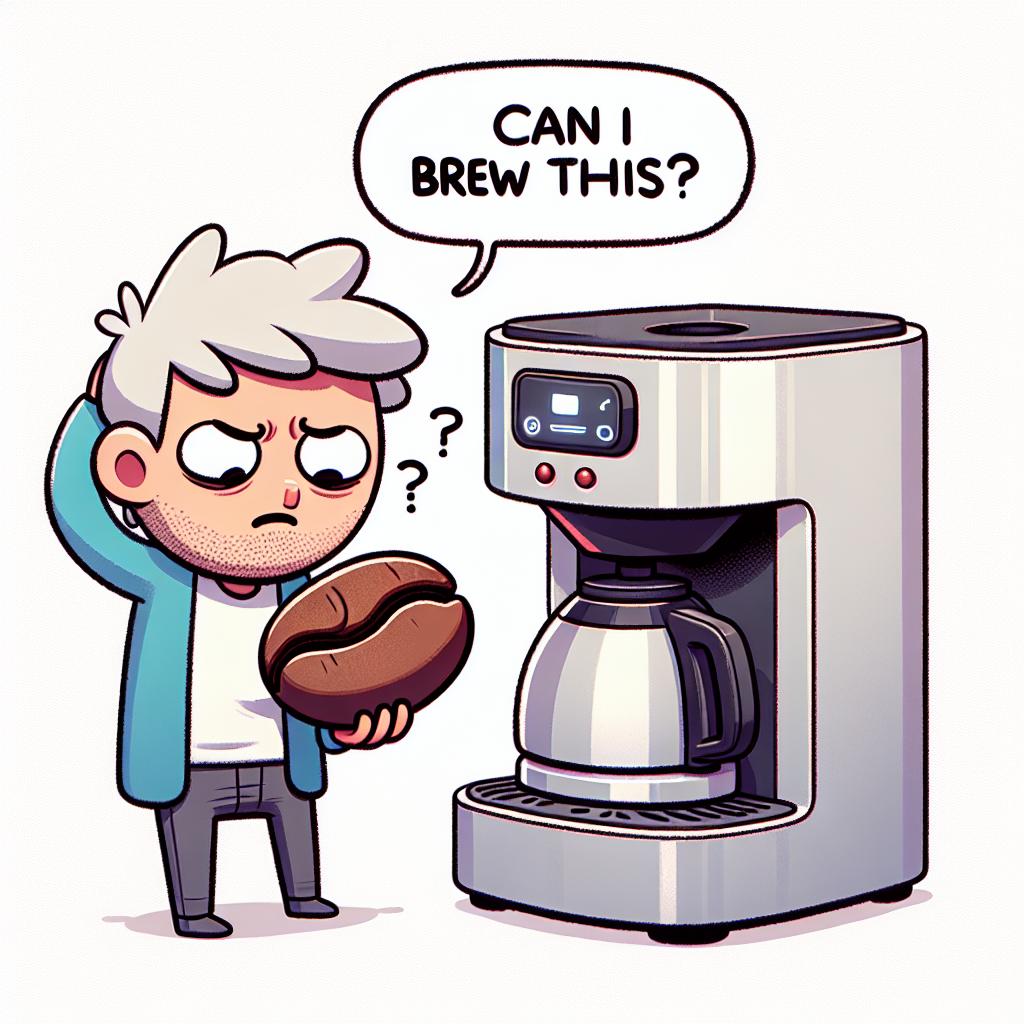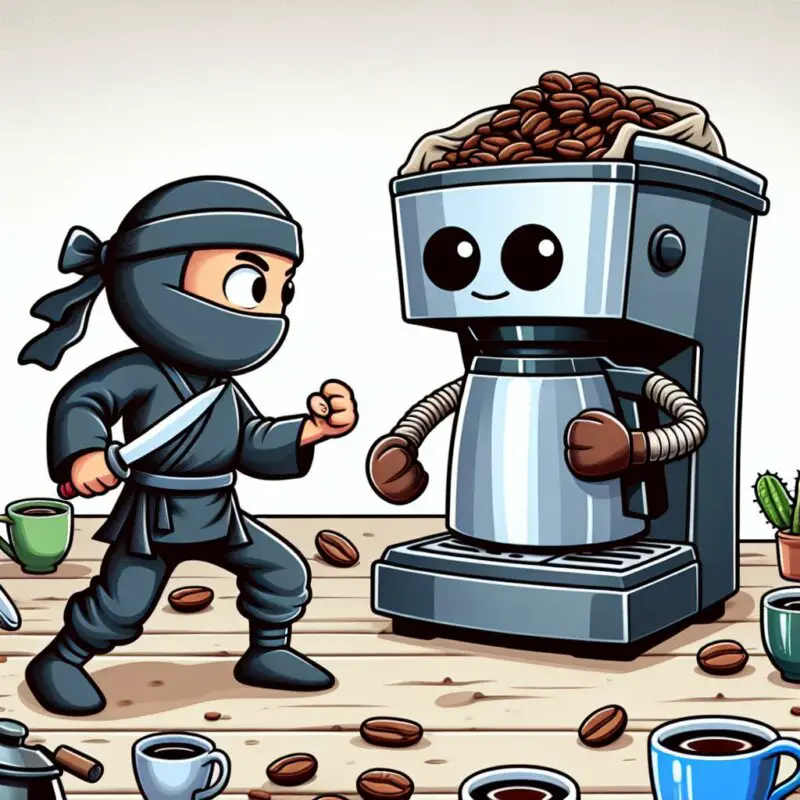This post may contain affiliate links. Please read my disclosure for more info.
Ever been on a trip and left your coffee grinder behind? Or maybe you accidentally picked up whole beans instead of ground coffee? Don’t worry, there’s still a way to enjoy that coffee without wasting it. Can you brew whole bean coffee, though?
Brewing coffee with whole beans using the double boiler or steeping methods is a fun adventure! These techniques might take a bit more time and beans than usual, but the reward is a smoother, less bitter, and less acidic cup of coffee.
Discover the secret to brewing coffee with whole beans! Before diving in, let’s explore the essentials of this unique coffee method. It’s simpler than you think, and I’ll guide you through it.
What Is Brewed Whole Bean Coffee?
Whole bean coffee without grinding skips the usual coffee-making steps. Instead of grinding, it soaks the whole beans directly. This means the beans sit longer in water, making the coffee taste milder than the typical ground coffee brew.
Brewing whole bean coffee vs ground coffee
- Whole bean coffee doesn’t use a coffee grinder. Bean coffee uses roasted coffee in its bean form rather than the consistent grounds you’ll get when grinding coffee beans.
- Whole bean coffee brews longer. Whole beans have less surface area than ground coffee, so water soaks less surface on the bean and dissolves fewer oils. As a countermeasure, brewing whole beans use more coffee and time.
To give you an idea, the whole bean coffee recipes you’ll find later in this article take about an hour to brew. Meanwhile, coffee drinks like espresso, cappuccino, and latte take less than a minute with the right coffee maker.
- Whole bean coffee uses more beans. As stated above, the increased amount of beans compensates for the lower surface area when brewing. Unfortunately, this solution becomes expensive as you use more beans than ground coffee.
- Whole bean coffee is less bitter and acidic. With a decreased contact area, water cannot efficiently dissolve the flavors from the beans. And so, the whole bean coffee tends to be less bitter and acidic than ground coffee.
- Whole bean coffee is a hit and miss. Unlike ground coffee, bean coffee gives you less control over the resulting strength and flavor. Sometimes, you’ll get a watery drink. Other times, it can be as delicious as ground coffee.
How to Make Coffee Beans into Coffee (No Grinder Needed!)
Double boiler method: How to brew coffee with whole beans
The first trick uses double boilers, which help control the heat perfectly for a more even coffee flavor. This method lets you brew whole beans directly, without grinding them first. Let’s dive into how it’s done.
What you need
- Whole coffee beans
- Filtered water
- Heat-proof container (mug, mason jar, etc.)
- Deep cooking pan
- Stove
- Strainer
- Tablespoon
- Cooking thermometer
Step-by-step instructions
- Fill a third of the jar with whole coffee beans. You may change the number of beans using a coffee-to-water ratio calculator. Remember that unground beans require longer brewing, so you can counter that by steeping more beans.
- Pour water into the pan. The volume of water should be enough for the jar and half the capacity of your cooking pan. You can either measure it accurately or estimate the water line somewhere above the midline of your pan.
- Heat the water. Monitor the temperature and take the pan off the flame before it boils. If you missed this stop, let the water rest until it falls within the optimum brewing temperature, 195 to 205 °F (91 to 96 °C).
- Pour hot water into the jar. Ensure the water stays within the temperature indicated above to promote proper extraction. Otherwise, you’ll have sour coffee due to under-extraction or bitter coffee from over-extraction.
- Place the jar over the pan. The water in the pan should not be too close to the jar opening to prevent boiling water from entering the container.
- Warm water under medium heat. At this point, you have a double boiler operating similar to that of high-end espresso machines. Essentially, the boiling water from the pan maintains the coffee temperature and allows it to steep in a more controlled setting.
- Stir the coffee. While your makeshift double boiler brews for 45 to 60 minutes, you may stir the coffee occasionally. Doing so promotes the extraction of whole beans.
- Strain the mixture. Once finished with steeping, strain the coffee and collect the residual beans. After all, no one wants chunks of coffee beans floating in their drink.
- Enjoy. Tap yourself on the back and take a sip of your delicious coffee!
Steeping method
The steeping method makes brewing whole bean coffee easy and travel-friendly. Whether you’re in a hotel room or at a convenience store with a hot water dispenser, you can enjoy fresh coffee anywhere.
Ready for coffee that moves with you? With this brewing method, you’re free to tackle your to-do list or hit the road while your coffee brews. Intrigued? Check out our easy recipe for on-the-go whole bean coffee!
What you need
- Whole coffee beans
- Filtered water
- Insulated container with lid (travel mugs, vacuum flask, etc.)
- Stove, water heater, microwave, hot water dispenser
- Coffee strainer
Step-by-step instructions
- Fill a third of the flask with whole coffee beans. Amount based on what you want
- Heat water. Optimal extraction happens with near-boiling water, so turn the heat down to around 195 to 205 °F (91 to 96 °C) or let the boiling water cool down.
Pro tip: Turn your Keurig into a water warmer. Unlike stoves and microwaves, it heats water without boiling, so you can relax without constantly checking on it.
- Fill the flask with hot water and whole coffee beans. The coffee beans should take up about a third of the flask, and the rest goes to water. However, if you’re fond of strong coffee, I suggest using more coffee beans to increase its concentration.
- Cover and shake the flask occasionally. Keep the lid tightly closed to prevent heat from escaping and letting the cap fly off during shaking. The constant steeping temperature and timely agitation promote proper extraction of coffee.
- Strain the mixture. After an hour, drain the coffee into another container with a fork or the built-in strainer of your flask.
- Enjoy. Drink your coffee or throw in a few ice cubes for a cold refreshment!
Should I Make Whole Bean Coffee Without Grinding?
Trying whole bean coffee without a grinder? It’s possible, but not the best idea for your daily cup. It costs more over time, takes longer, and sadly, you miss out on the rich flavors that make coffee amazing. Stick to grinding for the best brew!
Alternative options to whole bean coffee
Curious about moving from whole bean coffee? You’re in the perfect spot. Discover tips to elevate your coffee experience!
- Buy pre-ground coffee. You can purchase coffee beans in their bean form or ground form. By buying the latter, you won’t need a coffee grinder. However, store them properly to prevent the coffee grounds from going bad.
- Get a coffee grinder. With the best coffee grinders, you can maximize the flavors derived from your beans while minimizing the amount needed. Not to mention, fresh ground coffee makes a delicious cup of joe!
- Invest in a coffee maker with built-in grinders. If you have a bit more budget, I recommend going for a coffee maker with a built-in grinder. Some units even offer grind settings and other automatic features to make brewing easier on its users.
- Let Starbucks grind your coffee beans. Starbucks does not charge customers to grind unopened and unexpired coffee beans under their brand. So if you fit under the criteria, you can ask Starbucks to grind your beans.
- Switch to instant coffee. Different brands release instant coffee blends that may satisfy your craving for coffee. A good starting point is the Vietnamese coffee brands for a bold, robust flavor or Colombian instant coffee for a milder coffee flavor.
Frequently Asked Questions
Can you boil whole coffee beans to make coffee?
Well, yes and no. You need boiling water for whole bean coffee to maintain the steeping temperature – not to soak the beans directly. The setup involves boiling water surrounding the jar containing the coffee mixture.
Can you use whole coffee beans for cold brew?
Absolutely! You can either grind the beans with a coarse setting and steep overnight or soak the whole beans and steep even longer. However, the first method is more advisable since it follows the conventional way of making a cold brew.
Brewing Whole Bean Coffee Without a Grinder: Yay or Nay?
Whole bean coffee offers a unique brewing experience, moving away from traditional ground coffee for various coffee drinks.
Don’t have a grinder? No problem! You can still whip up a delicious cup of coffee. For a sweeter, creamier twist, add frothed milk. Prefer your coffee strong and bold? Check out my tips for enjoying black coffee. Either way, you’re in for a treat. Happy brewing!



